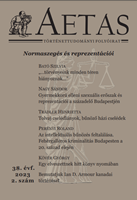Tolvaj cselédlányok, bűnöző házi cselédek
Thieving Housemaids, Criminal Servants
Author(s): Henrietta TrádlerSubject(s): Cultural history, Social history, 19th Century, Pre-WW I & WW I (1900 -1919), Interwar Period (1920 - 1939), WW II and following years (1940 - 1949), Sociology of Law
Published by: AETAS Könyv- és Lapkiadó Egyesület
Keywords: Thieving Housemaids; Criminal Servants; 19th and 20th centuries;
Summary/Abstract: The discourse surrounding domestic servants in the 19th and 20th centuries was remarkably negative, just like in the West, and considered servants to be second class, or inferior creatures. One of the primary issues was criminality. Domestic servants appeared in large numbers in crime statistics, they were most often convicted for theft and prostitution. Literature also reflected on the situation. Italian author Cesare Lombroso published his work L’uomo delinquente [The Criminal Man] in 1876, which had been translated to multiple languages, and inspired Raymond de Ryckert to write La servante criminelle [The Criminal Housemaid] in 1908. Ryckert classifies criminal servants, and examines the reasons behind crime and becoming a criminal. Regarding the criminality of servants, the figure of the good and the bad servant appear very distinctly in the opinions regarding servants, as well as in the analysis of these representations.
Journal: AETAS - Történettudományi folyóirat
- Issue Year: 2023
- Issue No: 2
- Page Range: 60-79
- Page Count: 20
- Language: Hungarian

